
 |
|
|||||||
| Home | Forums | Gallery | Register | Video Directory | FAQ | Members List | Calendar | Games | Today's Posts | Search | Chat Room |
  |
|
|
Thread Tools | Display Modes |
|
#1
|
||||||||||||||||||||||||||||||||||||||||||||||||||||||||||||||||||||||||||||||||||||||||||||||||||||||||||||||||||||||||||||||||||||||||||||||||||||||||||||||||||||||||||||||||||||||||||||||||||||||||||||||||||||
|
||||||||||||||||||||||||||||||||||||||||||||||||||||||||||||||||||||||||||||||||||||||||||||||||||||||||||||||||||||||||||||||||||||||||||||||||||||||||||||||||||||||||||||||||||||||||||||||||||||||||||||||||||||
Since their initial introduction in 1960, M113-based systems have entered service in more than 50 countries. The systems have been modified into more than 40 identified specific variants, with many times that number of minor field modifications. Many of these modifications have been developed by foreign governments to meet their specific national requirements. While some older M113 derivatives are being retired and removed from selected inventories, other FOV members are being upgraded, reconfigured, and introduced as entirely new systems. The first M-113's reached RVN in 1962. Originally destined for US units in W. Germany, 32 M-113's were used to outfit two ARVN mechanized company's fighting the VC in the Mekong Delta. These company's were modeled on US Army mechanized rifle company's. Each was organized into 3 rifle platoons with 3 M-113's in each platoon. A support platoon with 4 M-113's carried three 60mm mortars and three 3.5-inch bazookas. Despite being designed as an armored infantry vehicle to be used for carrying mechanized infantry into combat with armored columns of M-48's and M-60 main battle tanks on the plains of Europe, the ARVN units started using them as armored infantry combat vehicles in their own right. Early M-113's supplied to the ARVN were armed with a single M-2 .50 cal heavy machine gun on a pintle mount attached to the commander's cupola. Unfortunately these early M-113's provided no protection for exposed crew members, in particular the commander who manned the .50 cal machine gun. The loss of 14 ARVN gunners at the Battle of Ap Bac glaringly highlighted the need for some additional crew protection. Consequently the ARVN began furnishing their vehicles with makeshift gun shields. AMPHIBIOUS CAPABILITY The hull of the M-113 is fully watertight with all hatches having rubber seals which allows the vehicle to cross bodies of water and slow moving streams. To become amphibious, the vehicle driver turns on two bilge pumps and lowers the trim vane. and if they had dirt/sludge in them they would not function and water would build up inside.. 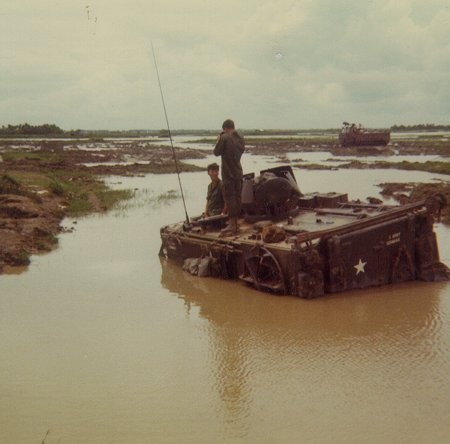 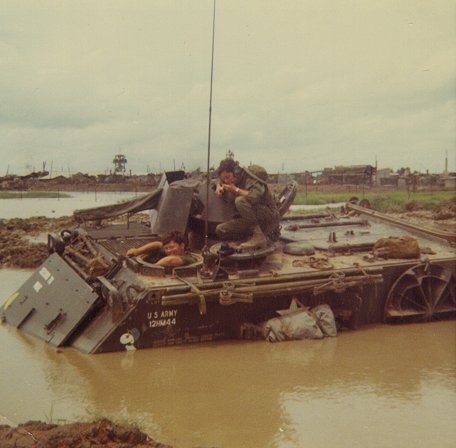 The trim vane is extended forward and helps maintain the correct balance of the vehicle in the water. It also prevents water from flowing over the front of the vehicle and into the drivers position or the front-mounted engine. The trim vane is extended forward and helps maintain the correct balance of the vehicle in the water. It also prevents water from flowing over the front of the vehicle and into the drivers position or the front-mounted engine.In the water the vehicle is propelled by the forward motion of it's tracks and could reach a speed of 3.5mph. Due to the fact that most crews severely overloaded their vehicles with stowage both inside and out, the amphibious capabilities of the vehicles were generally severely degraded and rarely used. More than 80,000 M113 Family of Vehicle (FOV) systems have been produced. New M113 FOV systems are being built while existing chassis are being upgraded to modern configurations. The M113 APC was the first modern "battle taxi"; developed to transport infantry forces on the mechanized battlefield. It is fitted with a 2 stroke six cylinder Detroit diesel providing power through a 3 speed automatic gearbox and steering differential. The main armament is a single .50 Cal heavy barrel machine gun, and the secondary armament is a single .30 Cal machine gun. The M113 is built of aircraft quality aluminum which allows it to possess some of the same strengths as steel at a much lighter weight. This distinct weight advantage allows the M113 to utilize a relatively small engine to power the vehicle, as well as carry a large payload cross-country. The vehicle is capable of "swimming" bodies of water.  These are the M113 variants I have found so far. I you know of any not in the list please let me know! M106 Mortar version with 106mm mortar. M113 Standard APC. M125 Mortar version with 81mm mortar. M132 M113 chassis with "Zippo" turret. I was assigned to these in Vietnam M150 TOW equipped version of the M113 M163 M113 chassis with 20mm M61 Vulcan gun. M548 M113 Transport version. M577 Command version with higher hull. M579 Fitter. M113 chassis with crane and large door instead of personnel door. M677 As M730 but with Lance missile. M727 As M548 but with Hawk missiles. M730 As M548 but without housed driver's compartment. Has turret with four MIM-72 AA missiles. M901 M113 chassis with TOW turret instead of ordinary commander's copula. M981 As M901 but with laser designator instead of TOW. M1015 EW Shelter. As M548 with EW equipment. M1059 M113A2 med M157 eller M54 smoke generator. XM734 M113 with gun ports in the sides. M113 Gasoline engine. M113A1 Diesel engine. M113A2 Improved cooling and suspension. M113A3 Improved engine and controls. External tanks and provision for add-on Armour.
M113 Armored Personnel Carrier 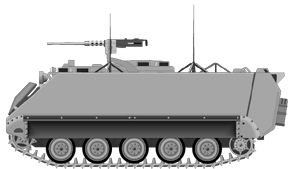 Standard Vehicle Data
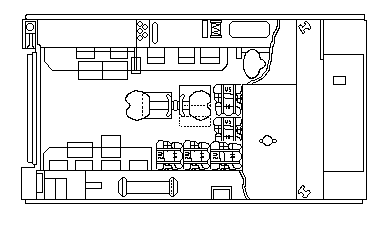  A Squadron was the equivalent of an Infantry Battalion; a Troop was the equivalent of an Infantry Company. Both organisations used the term Platoon. SQUADRON ORGANISATION A Squadron consisted of an HQ and HQ Troop, 3 Line Troops ( Troops A, B and C) and an Air Cavalry Troop (Troop D). This page only concerns itself with the organisation of a Line Troop. For information on Troop D, see Air Cavalry Troop Troop HQ Track 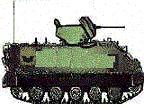 attack unit 6 1 x Captain (Troop Comdr) 1 x E6 (Vehicle Comdr) 1 x E4 (Driver) 1 x 1st Lt (Forward Artillery Observer) 1 x E4 (FAO's RTO) Troop Communications Track  attack unit 65 1 x E8 (1st Sgt. Track Comdr) 1 x E5 (Commo Chief, RTO) 1 x E4 (Driver) 2 x E4 (Radio Operator) 3 x E4 (Radio Mechanic) Radar Tracks
Platoon HQ Track  attack unit 16 1 x Lt (Platoon Comdr) 1 x E6 (Vehicle Cmdr) 1 x E4 (Driver) 1 x E3 (Observer) 1 x E4 (Plat Medic) 1 x E4 (Radio Operator) Scout Section
Infantry Track  attack unit 18 1 x E6 (Sqd Ldr) 2 x E5 (Team Ldr) 2 x E4 (M-60 Team) 2 x E4 (Grenadier) 1 x E4 (Driver) 2 x E3 (Rifleman) 1 x E4 (Radio operator) Mortar Track  attack unit 19 1 x E5 (Sqd Ldr) 1 x E4 (Mortar Gunner) 1 x E4 (Driver) 1 x E3 (Asst. Mortar Gunner) 1 x E3 (Ammo Bearer) 1 x E4 (Radio Operator) Tank Section
NOTES All APC's are depicted as ACAV's M113) unless stated otherwise, although, due to the problems associated with obtaining the ACAV kits as well as the damage inflicted on the vehicles by the bush/rubber it was often necessary to operate with standard M113's. ACAV's were armed with 1 x .50-cal mounted on the Commander's cupola and 2 x M60 mounted one either side of the rear troop compartment. The standard crew for the ACAV was a driver, track commander (who manned the .50 cal), two M-60 gunners and two loaders. All crew were armed with an M-16 and, in addition, a single M-79 40-mm grenade launcher was also carried in the vehicle. Typical ammo loads consisted of about 3,500 rounds of M2 .50 caliber, 8,500 rounds of 7.62mm M-60, 5,000 rounds of 5.56mm M-16 and 150 M-79 40mm grenades. Ammo loads for the tanks in the platoon typically consisted of; 500 rounds for the .50-cal, 45 rounds of cannister, 12 rounds HE, 7 rounds WP and 3 rounds of the 'new beehive'. As time progressed, the number of beehive rounds that were carried increased as the availability of this round grew. For further information on weapons see US Smallarms Communications Track The Commo track was at the center of Troop communications. The crew of this track had primary responsibility for the Troop radio net and for the maintenance of all the radio equipment in the Troop. Radar Tracks Both tracks of the Ground Surveillance Section carried PPS-4 radars. Although not listed in the official TO&E a ground-mounted, man portable PPS-5 radar was also carried. Ground Surveillance Radar were set up in front of the Troop's NDP or Laager and transmitted to a receiver in the Radar Track. It was intended to provide the Troop CO with early warning of enemy infiltration and their direction of approach. Medics Medics were usually assigned from Squadron. Several medics (E4, Medical Aidman) often rode on one of the Radar Tracks (Saber Bravo 40 or 41). This was because when the Troop was in action the Troop casualty clearing station was often secured by the Radar Tracks and the Commo Track. RTO's In addition to the RTO's on the Commo Track, attached to the Troop HQ, each Platoon also had 3 RTO's distributed amongst the vehicles as the Platoon CO saw fit. These RTO's were not part of the Troop Commo Section but were basically Infantrymen (11B20's) who may have had a secondary MOS of RTO (05B20) or, just by the luck of the draw, were volunteered for that slot. In the example above I have attached an RTO to each of the Platoon CO track, the Infantry track and the Mortar track. Combat Engineers It was quite common for a Combat Engineering Team of 4 men (1 x E5, 3 x E3) to be assigned to the Troop. The engineers were invariably assigned as passengers with the Scout Section and were responsible for sweeping in front of the Troop for mines and for jobs requiring demolitions with the use of C4 explosives. Infantry Squad The personnel of the infantry squad were quite often split amongst the various tracks of the Troop in order to provide those tracks with extra security. Mortar Track The Mortar Track was a modified M113 (not an ACAV) and could be either an M106 (4.2-inch mortar) or an M125 ( 81-mm mortar). Irrespective of the mortar type, the crew of five actually served the mortar itself. Tank Section The Tank section consists of 3 tanks. Originally the tank section consisted of the M48A3 but, as the war progressed, many units received the M551 Sheridan. 'B' Troop, 3/4 Cav received their Sheridans in late January 1969. By 1970 the tank section is likely to consist of Sheridan's. Prior to the arrival of the M551, some cavalry platoons of regimental cavalry squadrons, lacking M48A3's, were actually using ACAV's as substitutes for the tanks in this section. |
||||||||||||||||||||||||||||||||||||||||||||||||||||||||||||||||||||||||||||||||||||||||||||||||||||||||||||||||||||||||||||||||||||||||||||||||||||||||||||||||||||||||||||||||||||||||||||||||||||||||||||||||||||
| Sponsored Links |
|
#2
|
||||
|
||||
|
From my understanding of the replacement program of upgrading units from the old M113 MOGAS version to the Diesels, the 2-47th Inf (Mech), 9th Inf Div was the last unit in Vietnam to get the upgrades. Some of my platoon's APC, all ACAV's, had twice as many miles than the M113's in Korea, while the Korean-based US Army units would get their M113's DXed for new ones. We were blessed with some extraordinary mechanics who kept our tracks running despite metal fatigue, engine failures, and other calamities.
__________________
One Big Ass Mistake, America "Political correctness is a doctrine, fostered by a delusional, illogical minority, and rabidly promoted by an unscrupulous mainstream media, which holds forth the proposition that it is entirely possible to pick up a turd by the clean end." |
|
#3
|
|||
|
|||
|
David ffice
 ffice" /> ffice" />This has been driving me crazy for many years... Around 1969 I along with 9 other Marines were sent to a base in Georgia, I believe it was in Albany. I think it is a 10 week course with driving and complete top echelon maintenance. This APC or PC had a V8 Chevy/GM gas powered engine and a Turbo 350 or 400 transmission. A top speed of around 50MPH and of course could be driven in water. I remember an aircraft like steering wheel and a lever for normal and pivot operation The difference between M113... it was completely open and capable of 81 MM Mortar and 50 CAL... I have never seen a picture of the APC anywhere to this date. It had US ARMY markings that were faded and the joke was the entire floor housed an internal fuel tank and the vehicle either had a great deal or all magnesium incorporated, so it was like driving a bomb… Now I do have pictures of this somewhere and I can scan and send if needed …. Just thought you may know Thanks Ron |
|
#4
|
|||
|
|||
|
I'd like to see those pictures , Ron. David the ACAV also had added armor under the bottom front of the track and gun shields on the 60's
|
|
#5
|
||||
|
||||
|
Home sweet home for 11 months !!!
__________________

|
 |
|
|
 Similar Threads
Similar Threads
|
||||
| Thread | Thread Starter | Forum | Replies | Last Post |
| Remember How Liberals In Hollywood & Democrats Spat On Vietnam Vets After JFK's Vietnam War? | Arnold Wolfcaste | General | 0 | 01-20-2004 12:09 PM |
| The Day it Snowed in Vietnam: a true story (Christmas in Vietnam--1969), by Jim Schueckler | Otis Willie | General | 0 | 12-24-2003 09:19 PM |
| PLEASE LEAVE VIETNAM ALONE... VIETNAM HAD DONE HER SHARE IN LIBERATING THE WORLDRe: PoliticalEssays: A Grave Error | EL CHINO BOATMEN'S CONSCIENCE | General | 1 | 11-06-2003 10:36 PM |
| Vietnam War Casualties Author's Notes: by William F Abbott, Vietnam Veteran | Otis Willie | General | 0 | 08-31-2003 08:35 PM |
| VIETNAM SHOULD BAN EATING DOGS, CATS AND WILD ANIMALS......Re: It's a dog's life in Vietnam | EL CHINO | General | 40 | 08-25-2003 03:08 PM |


|